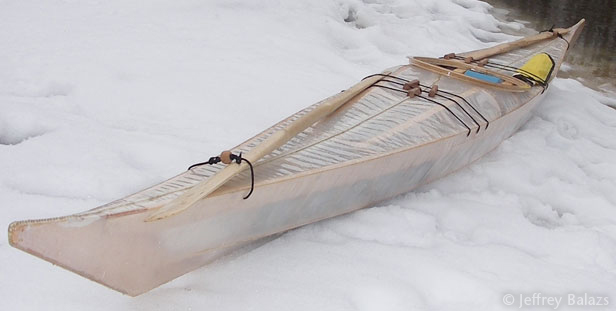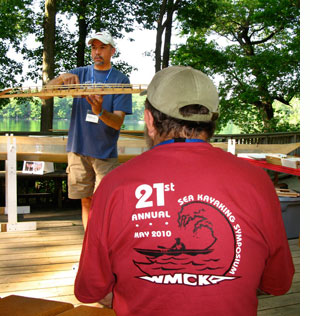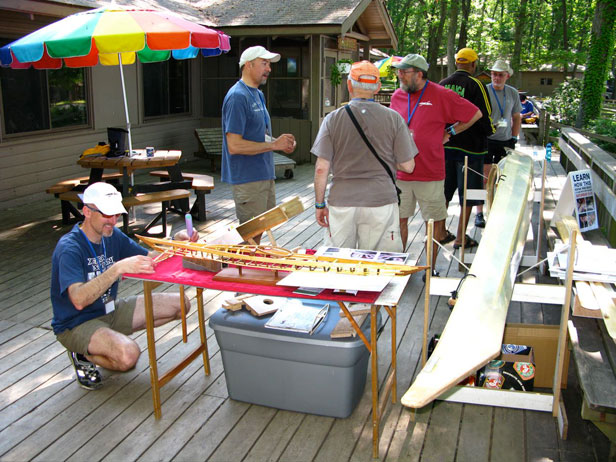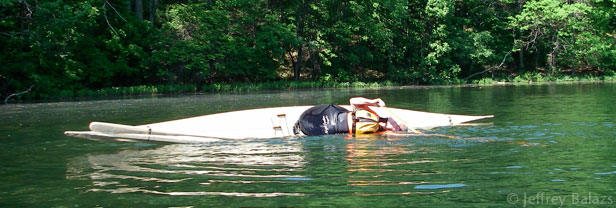I work professionally as a graphic designer and illustrator. A few of my hobbies include fine-woodworking and wooden boats. Together, both have managed to merge into a book project after building my first West Greenland kayak. Below are excerpts from the book,
The Journey of Building a West Greenland Kayak.

"As long as I can recall, I have always been attracted to water and watercraft. As a young kid, my two brothers, friends and I explored our pond in the plywood boat my father made and named the “S.S. Cadillac”. It served its first life well before it decayed from weather and rot. Some of the marine plywood later became the stems in my first kayak. I never finished “skinning” the 12-foot long frame even though it traveled with me throughout my college years. Yet, the dream stayed with me and took hold in another form.
Much later, in the spring of 2009, my good friend and I had a conversation about our admiration of the Greenland skin-on-frame-built kayak. Having owned and paddled fiberglass kayaks for many years, we thought it would be an ideal challenge to build our own. We debated the pros and cons of making an all-plywood, stitch-and-glue kayak versus a skin-on-frame. The more Mark and I talked, it became clear that a traditionally built boat would give us the most pleasure. In February, just for fun I made a scale-model of the kayak frame I had in my youth. In April, I began taking notes, made sketches of building jigs, steam boxes and other details. Further research online included reviewing kayak shapes, building techniques and compiling an inventory list of supplies we’d need.
Chris Cunningham’s book, Building a Greenland Kayak, was instrumental in getting the ball rolling. Robert Morris’ book Building Skin-On-Frame Boats, gave us insight to traditional Greenland building and steam bending tips. We also learned new nomenclature for the parts we’d have to make. The margins of the pages quickly started to include my own notes, observations and alterations that I wanted to incorporate. We’d take pleasure in our boats, knowing that the kayak would be held together only by waxed nylon sinew and wooden dowels without a single screw, nail or metal fastener! I was fortunate to have very close access to view two West Greenland boats created by Chris Cunningham and Bryan Nystrom. Each had their differences in shape, the quantity of ribs and the method used to stitch up the skin. By adding a larger cockpit, similar to what Nick Schade has used on his Greenland, Mark and I were ready to begin.
In June, I began calculating how much lumber Mark and I would need and where to buy it. I started making stands needed to support the boat during construction. They had to be stable as saw horses but also function as slings to be used as a cradles during the covering process. As we progressed through the months of part-time weekend or weekday escapes, the slats of wood began to resemble a boat.
 On June 29, 2009, We decided to start construction. Another friend had always wanted to transform his garage into a real wood-working shop and offered the ideal location to us. Shortly after, we moved in power and hand tools and an assortment of supplies.
On June 29, 2009, We decided to start construction. Another friend had always wanted to transform his garage into a real wood-working shop and offered the ideal location to us. Shortly after, we moved in power and hand tools and an assortment of supplies.
An intriguing aspect of building this type of kayak is that its very shape is scaled to fit the individual kayaker. The user’s physical anthropometric measurements - arm span, the width of a fist, hand, fingers, or their combinations, determine the length, width and depth of the boat and the location of key parts. For an example, the width of my boat equals to the width of my hips + a closed fist + two fingers (19”). Before we began cutting wood, we sat and balanced on a wooden plank and marked that center of balance location, along with locations of butt and heel bones (no-rib zones), knee caps, key support beams and rib locations. These points were transferred to a “story pole”, a record of our personal measurements that would be used to build the kayak."
We were very eager to get any available time in the shop, whether it was several or twelve hours at a stretch. The progress was rather fast, as I had done so much preparation and familiarizing myself with the successive steps. I also gave instruction to, and received different points of view in problem solving, from my fellow builder.

Some of the early steps were to cut, form and fit the upper deck beams in the mortises cut in the gunwales. The masik, a deck beam that lays over ones thighs for support, was made from a sassafras tree grown with an arch. It's shape and direction of grain adds to this beams strength.

After the top half of the boat was near completion, the proper height for the cockpit, stern and bow stems was determined by rigging on the floor.

I made a rib-bending jig, originally designed by Brian Nystrom, to aid in creating uniform ribs that had been steamed for 15 to 20 minutes. Keeping the steam hot was a key to sucessful bending.

The long lower backbone, called the keelson, was knotted to each rib in a series of loops. The ends were pegged to the stems near the clamp. The chines, a pair of stringers that lay on both sides of the keelson running fore and aft, were also knotted to the ribs in the same manner.

Now that the hull is complete and coated with tung oil, time was spent creating custom float bags made from heat-sealable oxford nylon. They filled the space forward of the foot brace and behind the seat, giving flotation in the event of a capsize.

The boats outer covering, an 8.5 ounce ballistic nylon, was stretched over the hull and tacked tight to the frame. The fabric edges were trimmed and wrapped around twin 1/8” cords that ran down the center of the foredeck. Using a pair of curved needles and waxed thread, the nylon was drawn tight and sewn from cockpit to both ends.

The coaming was laminated from 6 layers of 1/8” thick strips of Ash. Cherry wood was used for the center accent stripe. The coaming was temporarily attached to the boat by inserting nails through the holes drilled around its perimeter. The nails were replaced with the lashing of waxed thread for the final fastening.

Here is a view of the completed kayaks. At this stage the skin was semi-opaque and drum tight.

After saturating the nylon skin with a 2-part nonflammable urethane, the kayak covering became translucent, revealing our handiwork beneath the surface.

The maiden voyage in November 2009. This was a happy occasion, but there were other items to finish, such as deck lines, custom seat padding and paddle-making.

During the winter, I was able add deck lines, paddle parks, seat padding and make several paddles. Of course, I couldn't resist taking the boat out in the environment for which it was designed. Visit the other building links in the column to the left near the top of the page.
 In May 2010, I attended the 21st annual kayaking symposium sponsored by the Western Michigan Costal Kayakers Association held at Camp Pendalouan on Big Blue Lake during the Memorial Day weekend. As an instructor, I taught a class explaining the process of building this kayak, the tools used and allowed several interested attendees to try out the boat on the water. All were impressed with the boat's agility to roll and edge through turns.
In May 2010, I attended the 21st annual kayaking symposium sponsored by the Western Michigan Costal Kayakers Association held at Camp Pendalouan on Big Blue Lake during the Memorial Day weekend. As an instructor, I taught a class explaining the process of building this kayak, the tools used and allowed several interested attendees to try out the boat on the water. All were impressed with the boat's agility to roll and edge through turns.
Overviews were also given on traditional paddle construction. I gained valuable knowledge from Doug VanDoren on proper paddling techniques and suggestions regarding paddle shape for maximum efficiencies. Nigel Foster provided expert tips for positioning and paddling strokes.
I was honored to teach the same class in 2011.


Jim Mulder, owner of Gun Lake Paddle Sports, makes an impressive sweep roll, as he tests the kayak's performance. As a dealer at the symposium, Jim provided many boats, for attentees to test-paddle before making a purchase. His company also offers Nigel Foster kayaks, Trak Kayaks and Microlite trailers.

Over the years, the white nylon and clear uretahane coating on the boat has changed color to a light mellow tanned leather, giving an authentic look despite the semi-glossy sheen. In 2013 I made a sliding masik that provides better support over my thighs.
The Journey of Building
a West Greenland Kayak
by Jeffrey W. Balazs
A 62-page book filled with
construction details and
122 images.
Coaming support
& padded cockpit
Models
about me | building | links | adventures | | home
©2015 Jeffrey W. Balazs All Rights Reserved www.kayak4fun.net Site design by BalazsCreative.com